Edelstein-Keshet L. Mathematical Models in Biology
Подождите немного. Документ загружается.

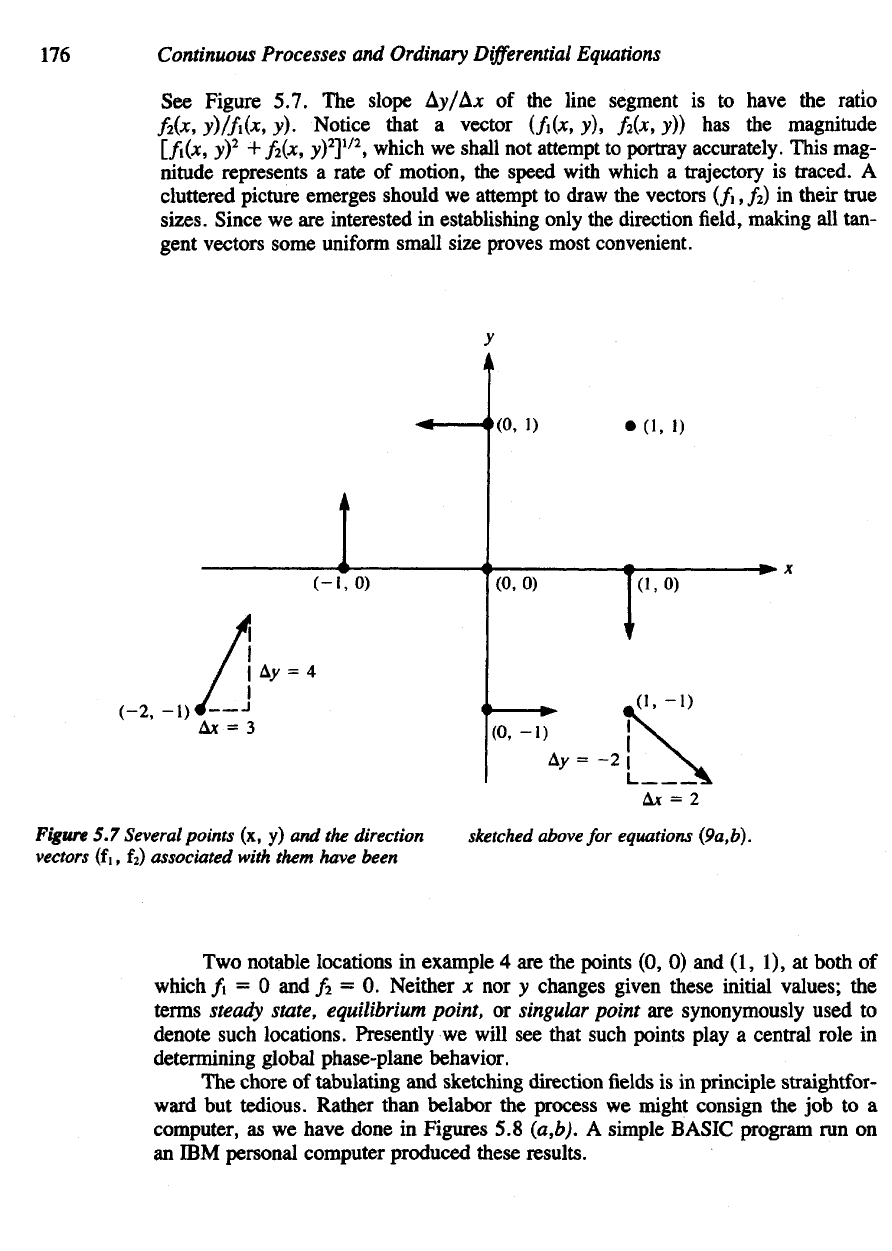
176
Continuous
Processes
and
Ordinary
Differential
Equations
See
Figure 5.7.
The
slope Ay/A*
of the
line segment
is to
have
the
ratio
f
2
(x,
y)/f\(x,
v).
Notice that
a
vector
(fi(x,
v),
f
2
(x,
v)) has the
magnitude
[/i(*i
y)
2
+
/2(*>
y)
2
]
1/2
,
which
we
shall
not
attempt
to
portray accurately. This mag-
nitude represents
a
rate
of
motion,
the
speed
with
which
a
trajectory
is
traced.
A
cluttered picture emerges should
we
attempt
to
draw
the
vectors (/i,
fa) in
their true
sizes.
Since
we are
interested
in
establishing only
the
direction
field,
making
all
tan-
gent vectors some
uniform
small size proves most convenient.
Two
notable locations
in
example
4 are the
points
(0, 0) and (1, 1), at
both
of
which
/i = 0 and /
2
= 0.
Neither
x nor v
changes given these initial values;
the
terms
steady
state, equilibrium point,
or
singular point
are
synonymously used
to
denote such locations. Presently
we
will
see
that such points play
a
central
role
in
determining global phase-plane behavior.
The
chore
of
tabulating
and
sketching direction
fields is in
principle
straightfor-
ward
but
tedious. Rather than belabor
the
process
we
might consign
the job to a
computer,
as we
have done
in
Figures
5.8
(a,b).
A
simple BASIC program
run on
an
IBM
personal computer produced these results.
Figure
5.7
Several points
(x, y) and the
direction
vectors
(f
i, f
2
)
associated with them have been
sketched
above
for
equations (9a,b).

Figure
5.8 (a)
Computer-generated vector
field for
solution curves
for
example
4. The
directions
are
example
4. The
vectors
point
sway
from
the
points ascertained
by
noting whether vectors
point
into
or
to
which
they
are
attached.
For
example, along
the out
of
the
region
at the
boundary
of
the
square,
positive
x
axis,
they
point
down,
(b)
Hand-sketched
(Computer
plot
by
Yehoshua
Keshet.)
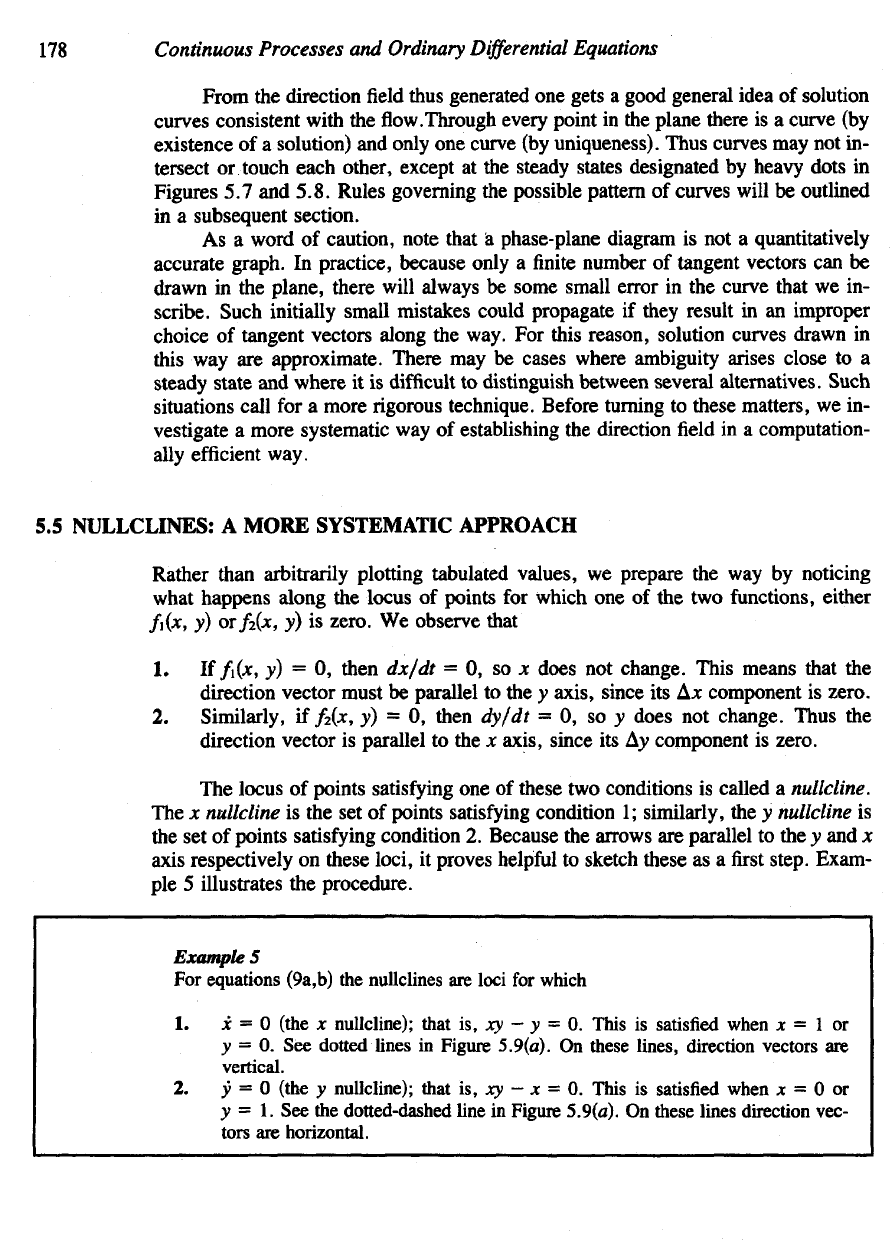
178
Continuous Processes
and
Ordinary
Differential
Equations
From
the
direction
field
thus
generated
one
gets
a
good general idea
of
solution
curves consistent with
the flow.Through
every point
in the
plane there
is a
curve
(by
existence
of a
solution)
and
only
one
curve
(by
uniqueness). Thus curves
may not in-
tersect
or
touch
each
other,
except
at the
steady states designated
by
heavy dots
in
Figures
5.7 and
5.8. Rules governing
the
possible pattern
of
curves will
be
outlined
in
a
subsequent section.
As a
word
of
caution, note that
a
phase-plane diagram
is not a
quantitatively
accurate graph.
In
practice, because only
a finite
number
of
tangent vectors
can be
drawn
in the
plane, there will always
be
some small error
in the
curve that
we in-
scribe. Such initially small mistakes could propagate
if
they result
in an
improper
choice
of
tangent vectors along
the
way.
For
this reason, solution curves drawn
in
this
way are
approximate. There
may be
cases where ambiguity arises close
to a
steady
state
and
where
it is
difficult
to
distinguish between
several
alternatives. Such
situations call
for a
more
rigorous
technique. Before turning
to
these matters,
we in-
vestigate
a
more systematic
way of
establishing
the
direction
field in a
computation-
ally
efficient
way.
5.5
NULLCLINES:
A
MORE SYSTEMATIC APPROACH
Rather
than arbitrarily plotting tabulated values,
we
prepare
the way by
noticing
what
happens
along
the
locus
of
points
for
which
one of the two
functions,
either
fi(x,
v)
or/
2
(jc,
y) is
zero.
We
observe that
1. If
fi(x,
y) = 0,
then dx/dt
= 0, so x
does
not
change. This means that
the
direction vector must
be
parallel
to the y
axis, since
its
AJC
component
is
zero.
2.
Similarly,
if
f
2
(x,
y) = 0,
then dy/dt
= 0, so y
does
not
change. Thus
the
direction vector
is
parallel
to the x
axis, since
its Ay
component
is
zero.
The
locus
of
points satisfying
one of
these
two
conditions
is
called
a
nullcline.
The x
nullcline
is the set of
points satisfying condition
1;
similarly,
the y
nullcline
is
the
set of
points satisfying condition
2.
Because
the
arrows
are
parallel
to the y and x
axis
respectively
on
these
loci,
it
proves
helpful
to
sketch these
as a first
step. Exam-
ple
5
illustrates
the
procedure.
Example
5
For
equations (9a,b)
the
nullclines
are
loci
for
which
1. x = 0
(the
x
nullcline); that
is, xy — y = 0.
This
is
satisfied when
x = 1 or
y
= 0. See
dotted lines
in
Figure
5.9(a).
On
these lines, direction vectors
are
vertical.
2. y = 0
(the
y
nullcline); that
is, xy - x = 0.
This
is
satisfied when
x = 0 or
y
= 1. See the
dotted-dashed line
in
Figure 5.9(a).
On
these lines direction vec-
tors
are
horizontal.

Phase-Plane
Methods
and
Qualitative
Solutions
179
Figure
5.9
Nullclines
and flow
directions
for
example
5. (a)
Nullclines, which happen
to
be
straight lines here,
are
sketched
in the
xy-plane
and
assigned vertical
or
horizontal
line
segments
in
(b).
(c)
Directions
are
determined
by
tabulating several values
and
inscribing
arrowheads,
(d)
Neighboring
arrows
are
deduced
by
preserving
a
continuous flow.
Points
of
intersection
of
nullclines
satisfy
both
x = 0 and y = 0 and
thus
rep-
resent steady states.
To
identify
these
and
determine
the
directions
of flow,
several
guidelines
are
useful.

180
Continuous Processes
and
Ordinary
Differential
Equations
Rules
for
determining
steady
states
and
direction vectors
on
nullclines
1.
Steady states
are
located
at
intersections
of an *
nullcline
with
a y
nullcline.
2. At
steady states there
is no
change
in
either
x or y
values; that
is, the
vectors
have zero length.
3.
Direction vectors must vary continuously
from one
point
to the
next
on the
nullclines. Thus
a
change
in the
orientation (for example,
from
pointing
up to
pointing down)
can
take place only
at
steady states.
We
note
that
(0, 0) and (1, 1) are the
only
two
steady states
in
example
5. It is im-
portant
to
avoid confusing these with other intersections,
for
example (1,0)
and
(0, 1), for
which only
one of the two
nullcline conditions
is
satisfied. Generally
it is
a
good idea
to
distinguish between
the x and y
nullclines
by
using
different
symbols
or
colors
for
each type.
It
should
be
remarked that
in
affixing
orientations
to the
arrows along null-
clines
we can
economize
on
algebra
by
being aware
of
certain geometric properties.
For
instance,
in
example
5 we
observe
the
following
patterns
of
signs:
X
0
1
0
+ , > 1
1
0
—
y
i
-
-
+
i
+,
> i
+
0
/.(*,
y)
+
0
0
+
0
-
0
/a(*.
y)
0
0
-
-
0
+
0
+
It
is
evident that
on
opposite sides
of a
steady-state point (along
a
given null-
cline)
the
orientation
of
arrows
is
reversed. This
is a
property shared
by
most sys-
tems
of
equations with
the
exception
of
certain singular cases.
(We
shall
be
able
to
distinguish
these exceptions
by
calculating
the
Jacobian
J and
evaluating
it at the
steady state
in
question.
If det J
=£
0, the
property
of
arrow reversal holds.)
In
most
cases
where
we
encounter
det J ^ 0, it
suffices
to
determine
the
direction vectors
at
one or two
select places
and
deduce
the
rest
by
preserving continuity
and
switching
orientation
as a
steady state
is
crossed.
Thus
the
arrow-nullcline method
can
reveal
a
fairly
complete picture with relatively
little
calculation (see example
6).
Example
6
Consider
the
equations
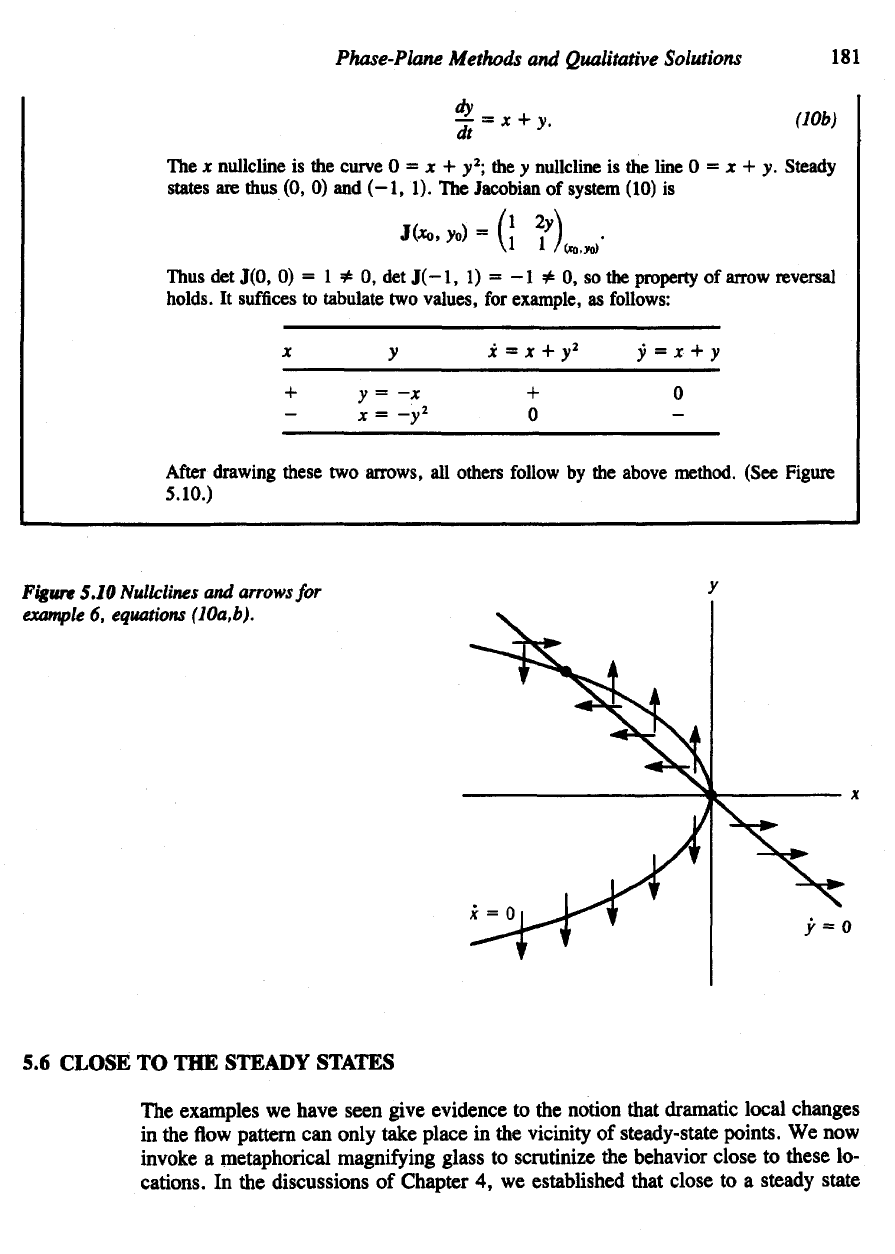
Phase-Plane
Methods
and
Qualitative
Solutions
181
The
x
nullcline
is the
curve
0 = x + y
2
; the y
nullcline
is the
line
0 = x + y.
Steady
states
are
thus
(0, 0) and
(-1,
1). The
Jacobian
of
system
(10)
is
Thus
det
J(0,
0) = 1 * 0, det
J(-l,
1) = -1 * 0, so the
property
of
arrow reversal
holds.
It
suffices
to
tabulate
two
values,
for
example,
as
follows:
After
drawing these
two
arrows,
all
others follow
by the
above method.
(See
Figure
5.10.)
Figure
5.10
Nullclines
and
arrows
for
example
6,
equations (10a,b).
5.6
CLOSE
TO THE
STEADY STATES
The
examples
we
have seen give evidence
to the
notion that dramatic local changes
in
the flow
pattern
can
only take place
in the
vicinity
of
steady-state points.
We now
invoke
a
metaphorical
magnifying
glass
to
scrutinize
the
behavior close
to
these
lo-
cations.
In the
discussions
of
Chapter
4, we
established that close
to a
steady state
X
+
-
y
y=-x
x=-y*
x
= x + y
2
+
0
y
= x + y
0
-
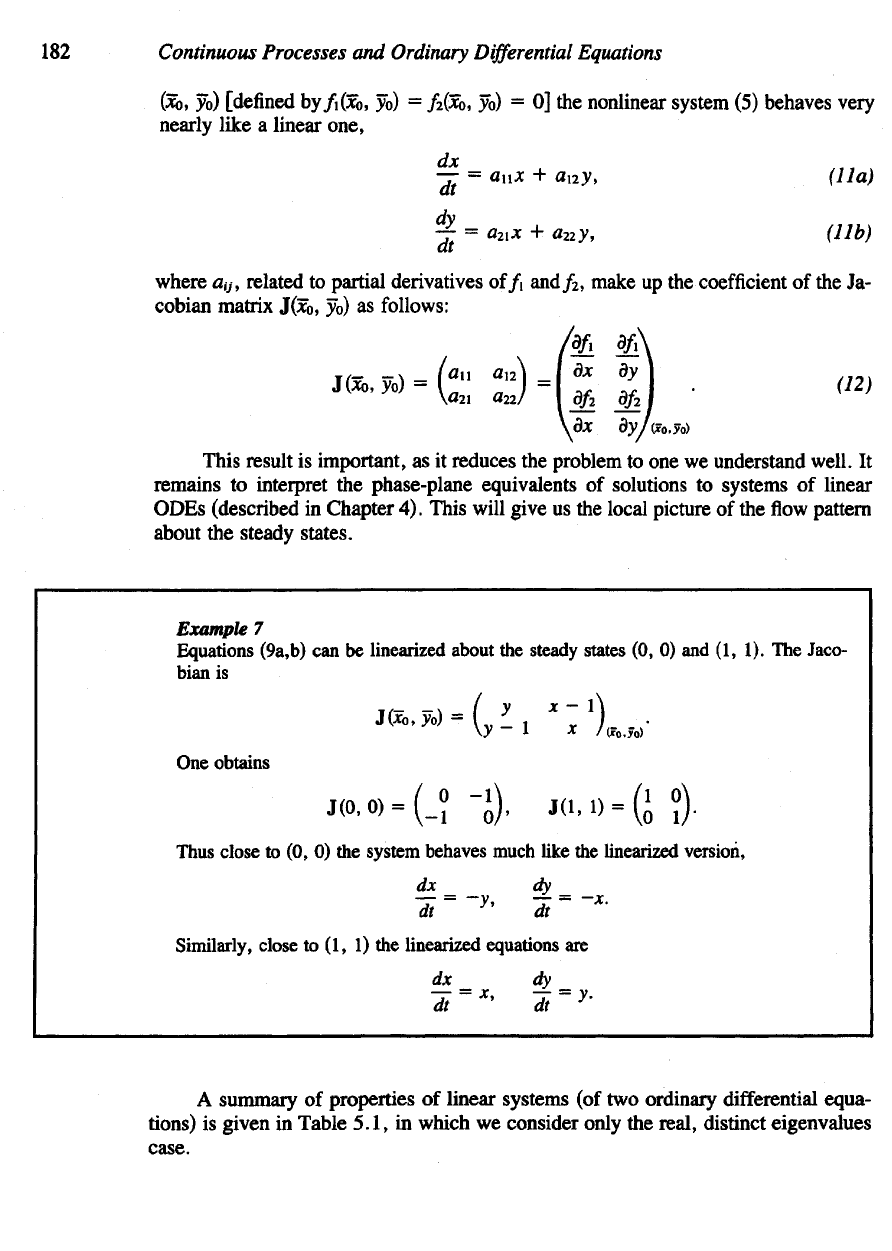
182
Continuous Processes
and
Ordinary
Differential
Equations
(XQ,
yo)
[defined by/i(x
0
,
yo) =
/2(*
0
,
yo) = 0] the
nonlinear system
(5)
behaves very
nearlv like
a
linear one.
where a
tj
, related
to
partial derivatives of/i
and/
2
,
make
up the
coefficient
of the Ja-
cobian matrix J(J
0
,
yo) as
follows:
This result
is
important,
as it
reduces
the
problem
to one we
understand well.
It
remains
to
interpret
the
phase-plane equivalents
of
solutions
to
systems
of
linear
ODEs (described
in
Chapter
4).
This will give
us the
local picture
of the flow
pattern
about
the
steady states.
Example
7
Equations (9a,b)
can be
linearized about
the
steady states
(0, 0) and (1, 1). The
Jaco-
bian
is
One
obtains
Thus
close
to (0, 0) the
system behaves much like
the
linearized
version
Similarly,
close
to (1, 1) the
linearized
equations
are
A
summary
of
properties
of
linear
systems
(of two
ordinary differential equa-
tions)
is
given
in
Table 5.1,
in
which
we
consider only
the
real, distinct eigenvalues
case.

Table
5.1
Linear
Systems
of two
ODEs
Equations
Significant
quantities
Characteristic equation
Eigenvalues
Identities
Eigenvectors
Solutions
Full
algebraic notation
jB
= OH +
0
2
2,
7 — On 0
2
2 ~
012021,
S
=
j8
2
- 4y
A
2
-
j8A
+. y = 0
A,
+ A
2
= j8,
jc
=
Cifli
2
e
A
«'
+
c
2
a
12
e
A2
',
y
=
d,e
A
i'
+ rf
2
c
A
2',
where
d\ -
CI(AI
- flu), d
2
=
c
2
(A
2
-
an).
Equivalent
Vector-Matrix Notation
Tr
A,
det
A,
disc
A
det
(A
- Al) = 0
A,
+ A
2
= Tr A,
A,A
2
= det A
YI
, v
2
such that
(A -
AI)v,
= 0
X
=
CiVi6
A
l'
+
C
2
V
2
C
A
2'.
£81
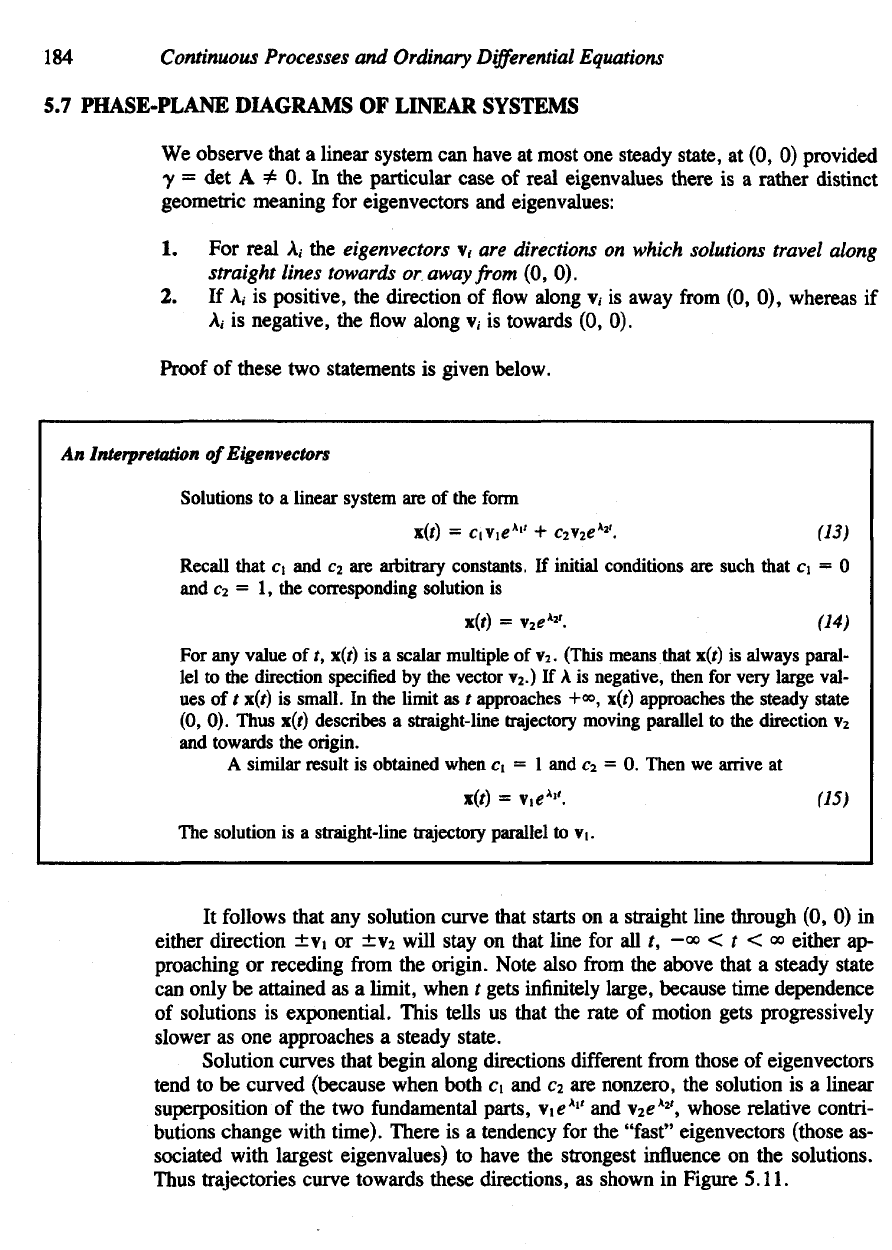
184
Continuous Processes
and
Ordinary
Differential
Equations
5.7
PHASE-PLANE DIAGRAMS
OF
LINEAR SYSTEMS
We
observe
that
a
linear system
can
have
at
most
one
steady state,
at (0, 0)
provided
y = det A
¥=
0. In the
particular
case
of
real eigenvalues there
is a
rather distinct
geometric meaning
for
eigenvectors
and
eigenvalues:
1. For
real
A, the
eigenvectors
v, are
directions
on
which solutions travel
along
straight
lines
towards
or
away
from
(0, 0).
2. If A, is
positive,
the
direction
of flow
along
v, is
away
from
(0, 0),
whereas
if
A,
is
negative,
the flow
along
v, is
towards
(0, 0).
Proof
of
these
two
statements
is
given below.
An
Interpretation
of
Eigenvectors
Solutions
to a
linear system
are of the
form
It
follows that
any
solution curve that starts
on a
straight line through
(0, 0) in
either direction
±Vi or ±v
2
will stay
on
that line
for all t, —« < t < «
either
ap-
proaching
or
receding
from
the
origin. Note also
from the
above that
a
steady state
can
only
be
attained
as a
limit, when
t
gets
infinitely
large, because time dependence
of
solutions
is
exponential. This tells
us
that
the
rate
of
motion gets progressively
slower
as one
approaches
a
steady state.
Solution curves that begin along directions
different
from
those
of
eigenvectors
tend
to be
curved (because when both
c\ and c
2
are
nonzero,
the
solution
is a
linear
superposition
of the two
fundamental parts,
VI£
AI
'
and
v
2
e
A2
', whose relative contri-
butions
change with time). There
is a
tendency
for the
"fast" eigenvectors (those
as-
sociated with largest eigenvalues)
to
have
the
strongest influence
on the
solutions.
Thus
trajectories curve towards these directions,
as
shown
in
Figure 5.11.
Recall that
c\ and c
2
are
arbitrary constants.
If
initial conditions
are
such that
c\ = 0
and
c-i
= 1, the
corresponding solution
is
For any
value
of /,
x(f)
is a
scalar multiple
of v
2
.
(This means that \(t)
is
always paral-
lel to the
direction specified
by the
vector v
2
.)
If A is
negative, then
for
very large val-
ues
of t
x(i)
is
small.
In the
limit
as t
approaches +°°, x(t) approaches
the
steady state
(0, 0).
Thus x(r)
describes
a
straight-line trajectory moving parallel
to the
direction
v
2
and
towards
the
origin.
A
similar result
is
obtained when
Ci
= 1 and c
2
= 0.
Then
we
arrive
at
The
is a
straight-line trajectory parallel
to
VL

Phase-Plane
Methods
and
Qualitative Solutions
185
Figure
5.11
Sketches
of
the
eigenvectors
(a-c)
and
solution
curves
(d-f)
of
the
linear equations
(lla,b)for
real eigenvalues.
The
signs
of
the two
eigenvalues
are as
follows:
(a, d),
both positive;
(b,
e),
opposite;
(c, f),
both negative.
Real
Eigenvalues
Assuming
that eigenvalues
are
real
and
distinct
(with
y
=£
0, j8
2
—
4y > 0
where
/3,
y are as
defined
in
Table
5.1 and
equation (16),
the
behavior
of
solutions
can be
classified
into
one of the
three possible categories:
1.
Both eigenvalues
are
positive:
AI > 0,
Aa
> 0.
2.
Eigenvalues
are of
opposite signs: e.g.,
AI
> 0, A
2
< 0.
3.
Both eigenvalues
are
negative:
AI
< 0, A
2
< 0.
In
these three cases
the
eigenvectors also
are
real. Both vectors point
away
from
the
origin
in
case
1 and
towards
it in
case
3. In
case
2
they
are of
opposite ori-
entations, with
the one
pointing outwards associated
with
the
positive eigenvalue.
Figure
5.11
(a
-
c)
illustrates this point.
